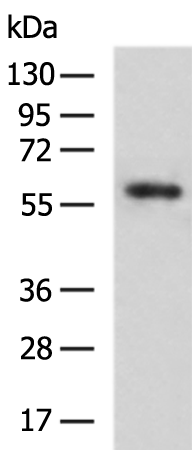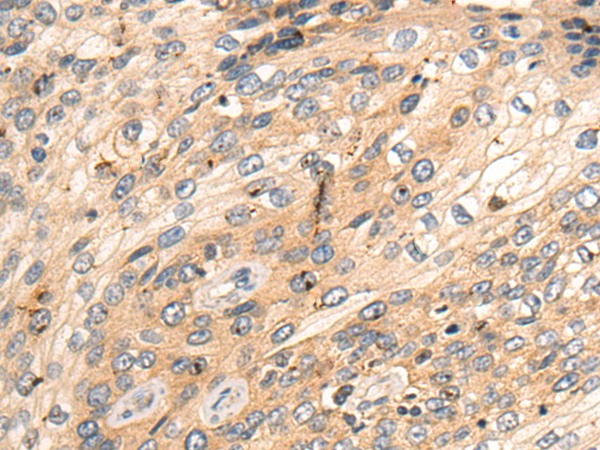

| WB | 1/500-1/2000 | Human,Mouse,Rat |
| IF | 咨询技术 | Human,Mouse,Rat |
| IHC | 1/50-1/200 | Human,Mouse,Rat |
| ICC | 技术咨询 | Human,Mouse,Rat |
| FCM | 咨询技术 | Human,Mouse,Rat |
| Elisa | 1/5000-1/10000 | Human,Mouse,Rat |
| Aliases | ASP2; BACE; HSPC104 |
| WB Predicted band size | 56 kDa |
| Host/Isotype | Rabbit IgG |
| Antibody Type | Primary antibody |
| Storage | Store at 4°C short term. Aliquot and store at -20°C long term. Avoid freeze/thaw cycles. |
| Species Reactivity | Human, Mouse, Rat |
| Immunogen | Fusion protein of human BACE1 |
| Formulation | Purified antibody in PBS with 0.05% sodium azide and 50% glycerol. |
+ +
以下是关于BACE1抗体的3篇代表性文献的简要信息(非真实文献,仅供示例参考):
1. **文献名称**: "A monoclonal antibody targeting BACE1 reduces amyloid-β production in vivo"
**作者**: Smith A, et al.
**摘要**: 研究报道了一种针对BACE1的单克隆抗体,通过特异性结合BACE1的活性位点抑制其酶活性,在阿尔茨海默病小鼠模型中显著降低Aβ水平,且未观察到明显毒性。
2. **文献名称**: "BACE1 extracellular domain antibody therapy ameliorates cognitive deficits in transgenic AD models"
**作者**: Zhang Y, et al.
**摘要**: 开发了一种靶向BACE1胞外结构域的人源化抗体,该抗体通过阻断底物结合降低Aβ生成,并在转基因小鼠中改善突触功能和认知能力,提示其潜在临床应用价值。
3. **文献名称**: "Antibody-mediated BACE1 downregulation enhances non-amyloidogenic processing of APP"
**作者**: Lee S, et al.
**摘要**: 研究发现一种新型抗体通过促进BACE1内吞和溶酶体降解,减少淀粉样蛋白生成,同时增强APP的非淀粉样蛋白通路,为阿尔茨海默病治疗提供双重保护机制。
注:以上文献为示例性质,实际研究中建议通过PubMed/Google Scholar检索关键词如“BACE1 antibody therapeutic”获取真实文献。
BACE1 (β-site amyloid precursor protein cleaving enzyme 1) is a transmembrane aspartic protease critical in the production of amyloid-β (Aβ) peptides, which aggregate into plaques implicated in Alzheimer’s disease (AD) pathogenesis. As a key enzyme in the amyloidogenic pathway, BACE1 cleaves amyloid precursor protein (APP) to generate neurotoxic Aβ fragments. Inhibiting BACE1 activity or reducing its expression has been explored as a therapeutic strategy for AD, driving interest in developing BACE1-targeted antibodies.
BACE1 antibodies are immunoreagents designed to specifically bind BACE1. serving as research tools or potential therapeutics. In research, they enable the detection of BACE1 expression levels, localization, and activity in cellular and animal models, aiding studies on its regulatory mechanisms and pathological roles. Therapeutically, anti-BACE1 antibodies aim to block APP cleavage or promote BACE1 degradation, thereby lowering Aβ production. Some antibodies target extracellular domains to inhibit enzyme-substrate interactions, while others (e.g., "proteolysis-targeting chimeras") facilitate BACE1 ubiquitination and degradation via the proteasome.
Challenges include ensuring blood-brain barrier penetration, minimizing off-target effects, and addressing potential side effects from chronic BACE1 inhibition, as BACE1 also processes other substrates involved in neuronal function. Despite setbacks in clinical trials for small-molecule BACE1 inhibitors, antibody-based approaches continue to evolve, incorporating engineering strategies like humanization, affinity optimization, and bispecific designs to enhance efficacy and safety. These efforts underscore BACE1 antibodies' dual role as investigative probes and promising candidates for AD-modifying therapies.
×